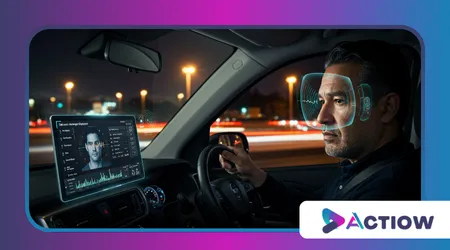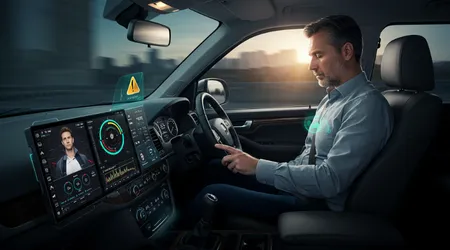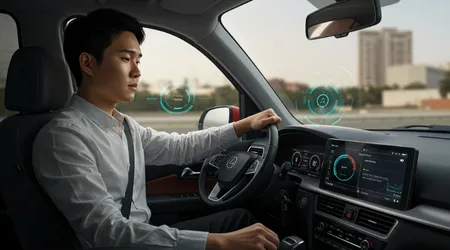Driver Fatigue Monitoring Systems: Technology That Saves Lives

Anúncios
Driver fatigue monitoring systems are revolutionizing automotive safety in 2025, blending cutting-edge tech with human-centric design to keep roads safer.
Imagine driving late at night, eyes heavy, focus slipping then a gentle alert nudges you awake.
That’s the magic of this innovation, a guardian angel embedded in your vehicle. Fatigue-related crashes, once a silent epidemic, now face a formidable foe.
Anúncios
This isn’t just about gadgets; it’s about lives preserved through smart engineering.
Today, we’ll dive into how these systems work, why they matter, and where they’re headed buckle up for a journey through technology that’s rewriting the rules of the road.
Picture this: a trucker hauling cargo across state lines, miles stretching endlessly ahead, exhaustion creeping in.
Or a parent rushing home after a long shift, fighting to stay alert. These scenarios aren’t rare they’re daily realities, and fatigue doesn’t discriminate.
The National Highway Traffic Safety Administration reported in 2023 that drowsy driving caused over 600,000 crashes yearly in the U.S. alone.
That’s a staggering number, each statistic a story of loss or near-miss.
Enter driver fatigue monitoring systems, not as a luxury, but as a necessity tools that detect, alert, and protect, turning potential tragedies into moments of relief.
This isn’t sci-fi; it’s 2025, and the tech is here, evolving fast. From brainwave sensors to eye-tracking cameras, these systems are more than buzzwords they’re lifelines.
Carmakers, regulators, and tech innovators are racing to perfect them, driven by a shared goal: zero fatalities.
So, let’s explore the nuts and bolts, the real-world impact, and the future promise of this game-changing technology.
Whether you’re a gearhead or just someone who drives, this is a story that hits close to home because safety isn’t optional, it’s personal.
How These Systems Work: The Tech Behind the Magic
Ever wondered how your car knows you’re drifting off? It starts with sensors tiny, brilliant spies watching your every move.
Cameras track eye blinks, head tilts, and yawns, feeding data to algorithms that scream “wake up” when patterns shift.
Hyundai’s M.Brain, for instance, uses brainwave analysis, a world-first that reads your mind’s fatigue signals. It’s not invasive; it’s intuitive, alerting you with beeps or vibrations before disaster strikes.
Beyond cameras, steering sensors join the party, noticing erratic swerves or lazy grips subtle clues of a drowsy driver.
Pair that with AI, and you’ve got a system smarter than your average copilot, learning your habits over time.
In 2025, companies like Smart Eye lead with multimodal tech, blending emotion AI and gaze tracking, ensuring no sleepy moment slips through.
The result?
++ Level 5 Autonomous Driving Technology: When Will It Hit the Market?
A car that cares, actively fighting fatigue with precision and grit.
But it’s not just about detection response matters too, and that’s where integration shines.
These systems sync with ADAS, slowing your ride or suggesting coffee stops via navigation. Imagine your dashboard flashing “Take a Break!” as it guides you to the nearest rest area.
It’s practical, seamless, and built for real life, proving tech can be both brainy and brawny in the fight against drowsy driving.

Why Fatigue Matters: The Hidden Danger on Our Roads
Fatigue isn’t just tiredness it’s a killer, lurking in plain sight, underestimated until it’s too late.
Your brain slows, reflexes dull, and decisions blur, turning a routine drive into a gamble. Studies show drowsy drivers are as impaired as drunk ones, yet we shrug it off until the headlights fade.
That 2023 NHTSA stat? It’s not just data; it’s a wake-up call, urging us to act before the crash.
Think about long-haul truckers, night-shift nurses, or even teens after a late game fatigue doesn’t care who you are.
Also read: Solid-State Battery Technology: The Future of Electric Cars
It’s universal, relentless, and sneaky, hitting hardest when you think you’re fine. Driver fatigue monitoring systems step in here, not as nannies, but as partners, catching what pride or caffeine can’t.
They’re the difference between a close call and a coffin, a truth we can’t ignore in 2025.
And it’s not just individuals fleets feel the sting too, with fatigue costing billions in wrecks and downtime.
Companies like Caterpillar now outfit mining rigs with these tools, slashing risks and boosting uptime.
It’s a ripple effect: safer drivers, happier families, thriving businesses all from tech that sees what we can’t, proving vigilance pays off in more ways than one.
The Evolution of Driver Fatigue Monitoring Systems
These systems didn’t spring up overnight they’ve grown from clunky ideas to sleek lifesavers, shaped by decades of trial and error.
Early versions relied on basic steering inputs, crude but effective for their time, alerting drivers with buzzers.
Fast-forward to 2025, and we’re in a new era AI, machine vision, and biosensors team up, making yesterday’s tech look like a toy.
Read more: Active Safety Systems: Technologies That Prevent Accidents
Take Seeing Machines’ Guardian Generation 3, launched in 2024 it’s a retrofit marvel, proving old fleets can get new tricks.
Meanwhile, Smart Eye’s AIS blends hardware and software, hitting trucks and buses with pinpoint accuracy.
This evolution isn’t random; it’s driven by regs like EU 2019/2144, mandating DMS in new cars, pushing innovation into overdrive and saving lives along the way.
The shift isn’t just tech it’s cultural, with drivers embracing these tools as allies, not annoyances.
Carmakers like Volvo and Toyota lead the charge, embedding advanced systems in everyday rides, democratizing safety.
What started as a premium perk is now standard, a testament to how far we’ve come, and a hint at how much further we can go.
Real-World Impact: Stories and Stats That Hit Home
Picture a trucker named Mike, hauling freight at 3 a.m., eyes drooping then his rig beeps, lights flash, he pulls over.
That’s no hypothetical; it’s happening daily, thanks to driver fatigue monitoring systems cutting crash rates.
A 2024 study by ScienceDirect found fleets with DMS saw accident drops of 15-20%, real proof this tech delivers.
Or consider Lisa, a mom driving home post-shift, her Kia’s DAW nudging her awake she makes it, kids still have a mom.
These aren’t just stories; they’re victories, small but seismic, rippling through communities.
The data backs it up: North America, with 35% DMS market share in 2023, leads adoption, driven by strict rules and savvy firms.
And it’s not just lives economics shift too, with insurers offering discounts for equipped vehicles, a win-win for wallets and well-being.
From rural highways to urban sprawls, this tech rewrites outcomes, turning “what if” into “thank God” a human triumph fueled by silicon and smarts.
Challenges and Pushbacks: Not All Smooth Roads Ahead
Nothing’s perfect, and driver fatigue monitoring systems face hurdles cost, for one, can sting small operators, slowing adoption.
Retrofitting older cars?
Tricky and pricey, leaving gaps in coverage, especially in cash-strapped regions. Privacy’s another thorn cameras watching you 24/7 spark unease, even if data’s locked tight.
False positives annoy too imagine your car scolding you for a yawn after a big lunch, not a nap. Tech’s improving, but glitches linger, testing patience and trust.
Regulatory lag doesn’t help; while the EU pushes, other markets dawdle, leaving a patchwork of safety that frustrates advocates and drivers alike.
Yet, pushback fuels progress carmakers tweak algorithms, cut costs, and soothe privacy fears with transparency.
It’s a bumpy ride, but the destination safer roads keeps the wheels turning, proving challenges are just pit stops, not dead ends, in this life-saving quest.
The Future: Where This Tech Takes Us Next

Gaze into 2025’s horizon, and driver fatigue monitoring systems morph into something bolder think full cockpit awareness, sensing every occupant’s vibe.
Autonomous driving looms large; at SAE Level 4, these tools shift from crash prevention to comfort, ensuring you’re rested for the handoff. It’s not just safety it’s experience.
Integration’s the buzzword DMS ties into health apps, tracking sleep patterns, suggesting breaks before you buckle.
Picture your car chatting with your smartwatch, nudging you to nap, then brewing coffee via an in-dash system. Sci-fi?
Nope, it’s 2026’s roadmap, with firms like Bosch and Magna already prototyping these leaps.
And sustainability joins the fray energy-efficient sensors cut carbon footprints, aligning with 2025’s green push.
From mines to minivans, this tech scales up, promising a future where fatigue’s a relic, and driving’s a breeze a vision worth chasing, one alert at a time.
A Closer Look: Comparing Top Systems in 2025
Let’s break it down how do today’s top driver fatigue monitoring systems stack up?
Table 1 dives in, spotlighting features and brands rocking the scene.
| System | Brand | Key Feature | Unique Edge |
|---|---|---|---|
| M.Brain | Hyundai Mobis | Brainwave analysis | World’s first mind-reader |
| Guardian Gen 3 | Seeing Machines | Retrofit compatibility | Old fleets get new life |
| AIS | Smart Eye | Multimodal AI | Emotion and gaze tracking |
Each shines differently M.Brain’s futuristic, Guardian’s practical, AIS is versatile, catering to varied needs.
Hyundai’s ahead in innovation, while Seeing Machines nails accessibility, and Smart Eye blends it all, showing how competition drives progress.
Now, peek at adoption stats Table 2 shows who’s leading the charge by region, based on 2024 market insights.
| Region | Market Share | Key Driver | Growth Rate |
|---|---|---|---|
| North America | 35% | Strict safety regs | 9.8% CAGR |
| Europe | 30% | EU 2019/2144 mandate | 10.2% CAGR |
| Asia-Pacific | 25% | Rising car sales | 11.5% CAGR |
North America’s got the edge, but Asia’s sprinting, fueled by demand and tech hunger numbers that scream opportunity and urgency.
Conclusion: A Road Worth Traveling Together
Driver fatigue monitoring systems aren’t just tech they’re a promise, a pact to keep us safe, thriving in 2025’s fast lanes.
They’ve evolved from niche to norm, catching yawns, saving lives, reshaping how we drive. From Mike’s rig to Lisa’s sedan, the impact’s real, personal, undeniable technology with heart, not just circuits.
But it’s not done challenges linger, futures beckon, and we’re all in this ride.
Carmakers innovate, drivers adapt, regulators push, and the result?
Roads where fatigue’s a memory, not a menace. Think of the lives untouched by grief, the families whole this isn’t just progress; it’s purpose, raw and human.
So, next time you hit the highway, know this: those sensors, those alerts, they’re more than code they’re your backup, your shield.
Driver fatigue monitoring systems prove tech can care, fiercely and quietly, mile after mile.
Let’s cheer this revolution, demand its growth, because safety’s not a perk it’s our right, our legacy, our win.
